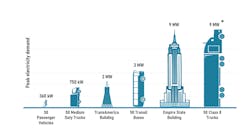Collaboration key to grid readiness: NAFA panel
LONG BEACH, California—As transportation electrification accelerates, a critical partnership is emerging between fleets and utility companies, but challenges to the development of essential charging infrastructure remain. Specifically, utilities and public regulators must learn to be proactive and invest in the grid ahead of demand to spur commercial EV adoption, or so a panel representing fleets and utilities agreed in a discussion here at NAFA I&E 2025.
The session highlighted the complex challenges and innovative solutions required to transition to EVs while maintaining grid reliability successfully.
Indeed, as Mike Rowand, a senior adviser for EPRI and the panel moderator, framed the conversation, "How can fleets help utilities help fleets?"
The stakes are high. Chanel Parson, director of clean energy and demand response for Southern California Edison, noted that California aims to have 90% of light-duty vehicles and 54% of heavy-duty vehicles running on electricity by 2045. This ambitious goal comes with a projected 80% growth in electricity demand—a challenge that requires unprecedented collaboration and strategic planning.
Key grid challenges
Utilities face multiple hurdles in supporting widespread EV adoption. The traditional model of waiting for customer requests is no longer sufficient.
"We've changed our approach from being reactive to proactive," said Brian Zulberti from Duke Energy. "We ask customers come to us as soon as you have the idea of electrifying, that way we can try to build out a plan and be with you as you're planning.”
This means engaging with potential EV adopters years before infrastructure upgrades are needed.
But the regulatory environment remains a significant challenge.
Not on the panel but called upon during the discussion, Phil Jones, executive director at Alliance for Transportation Electrification, noted that while progress is being made in some states, many state commissions remain cautious due to concerns about affordability and grid capacity, with the added pressure on demand from data centers.
“The commissioners are very concerned about affordability,” Jones said. “You put capital into rates, rates go up. So have we made it on progress? No, that's the basic answer.”
And the complexity of grid upgrades is significant.
Parson outlined six critical factors that impact infrastructure projects, all carrying unknowns and risk: project type, site characteristics, capacity needs, permitting, material availability, and customer engagement.
Each of these elements can dramatically extend project timelines, creating potential bottlenecks for fleet electrification, she suggested.
“The time to get permits and the material are ones that are not completely under the utilities’ control,” Parson said. “And those are ones that there could be a wildcard.”
See also: NAFA Media Day highlights innovations, industry advances
Innovative solutions and strategies
The panel highlighted several promising approaches to address these challenges:
- Early engagement: Utilities are encouraging fleets to communicate electrification plans as early as possible. This allows for proactive grid planning and infrastructure development.
- Flexible solutions: Southern California Edison is exploring interim solutions like flexible interconnection, mobile storage, and microgrid technologies to support EV charging needs.
- Charging-as-a-Service: New subscription-based charging models are emerging, allowing fleets to electrify without significant up-front capital investment.
Fleet perspectives
Fleet managers are equally crucial in this transformation. Bradley Northup from the City of Carlsbad (California) emphasized the importance of understanding fleet characteristics.
"Know your fleet," he said, pointing to vehicle types, usage patterns, and potential electrification opportunities. “If you don't know your fleet, you can't have a conversation.”
Parson agreed.
“If you're talking to us early, we can help educate you on the utility process,” she said. “But it also helps for you to educate us on the fleets and the characteristics of the fleets. So again, see us as a partner and talk.”
Peter Nogalo, industry relations manager for Holman, reiterated the importance of coming in prepared.
“Data, data, data,” Nogalo said. “What, where are these vehicles? How are they being used? What time of day are they being used? What are they carrying?”
Practical recommendations
The panelists offered clear advice for successful fleet electrification:
For Fleets:
- Communicate early and often with utilities
- Provide detailed data about fleet vehicles and usage
- Be flexible in electrification planning
- Explore innovative charging solutions
For Utilities:
- Develop proactive grid upgrade strategies
- Create flexible interconnection options
- Offer advisory services and incentive programs
- Engage with fleets as partners, not just service providers
In sum, successful transportation electrification requires unprecedented cooperation between fleets, utilities, and regulators. By embracing early communication, data-driven planning, and innovative solutions, stakeholders can navigate the complex path to a more sustainable transportation future.
To that end, Rowand concluded the session by emphasizing the importance of engagement. He noted that NAFA will be leading an effort to gather information from association members to share with the utilities industry and pointed out that EPRI had a booth at I&E for the first time, using the event to offer electrification tools to fleet managers.
The message is clear: The grid of tomorrow is being built through collaboration today.
About the Author
Kevin Jones
Editor
Kevin has served as editor-in-chief of Trailer/Body Builders magazine since 2017—just the third editor in the magazine’s 60 years. He is also editorial director for Endeavor Business Media’s Commercial Vehicle group, which includes FleetOwner, Bulk Transporter, Refrigerated Transporter, American Trucker, and Fleet Maintenance magazines and websites.
Working from Beaufort, S.C., Kevin has covered trucking and manufacturing for nearly 20 years. His writing and commentary about the trucking industry and, previously, business and government, has been recognized with numerous state, regional, and national journalism awards.


